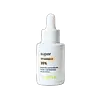What's inside
What's inside
 Key Ingredients
Key Ingredients

 Benefits
Benefits

 Concerns
Concerns

 Ingredients Side-by-side
Ingredients Side-by-side

Water
Skin ConditioningPropanediol
SolventDicaprylyl Ether
EmollientButyrospermum Parkii Butter
Skin ConditioningUndecane
EmollientAcacia Senegal Gum
MaskingLactic Acid
BufferingAscorbyl Glucoside
AntioxidantAscorbyl Palmitate
AntioxidantAscorbic Acid
AntioxidantMaltobionic Acid
BufferingPhytic Acid
Palmitoyl Tetrapeptide-10
Skin ConditioningOryza Sativa Seed Protein
AntioxidantOryza Sativa Extract
AbsorbentHydrolyzed Caesalpinia Spinosa Gum
AbsorbentCaesalpinia Spinosa Gum
Skin ConditioningBiosaccharide Gum-1
HumectantPhenoxyethanol
PreservativeXanthan Gum
EmulsifyingTridecane
PerfumingSodium Hydroxide
BufferingGlyceryl Caprylate
EmollientCitric Acid
BufferingGlycerin
HumectantSodium Gluconate
Skin ConditioningEthylhexylglycerin
Skin ConditioningPunica Granatum Seed Oil
EmollientPPG-15 Stearyl Ether
EmollientSteareth-2
EmulsifyingSteareth-21
CleansingPoloxamer 407
EmulsifyingTocopheryl Acetate
AntioxidantAlcohol
AntimicrobialGlyceryl Undecylenate
EmollientSodium Levulinate
Skin ConditioningCaprylic/Capric Triglyceride
MaskingSodium Anisate
AntimicrobialCetyl Palmitate
EmollientSorbitan Stearate
EmulsifyingPolysorbate 80
EmulsifyingGluconolactone
Skin ConditioningSodium Benzoate
MaskingTocopherol
AntioxidantPotassium Sorbate
PreservativeHydrogenated Lecithin
EmulsifyingCalcium Gluconate
HumectantWater, Propanediol, Dicaprylyl Ether, Butyrospermum Parkii Butter, Undecane, Acacia Senegal Gum, Lactic Acid, Ascorbyl Glucoside, Ascorbyl Palmitate, Ascorbic Acid, Maltobionic Acid, Phytic Acid, Palmitoyl Tetrapeptide-10, Oryza Sativa Seed Protein, Oryza Sativa Extract, Hydrolyzed Caesalpinia Spinosa Gum, Caesalpinia Spinosa Gum, Biosaccharide Gum-1, Phenoxyethanol, Xanthan Gum, Tridecane, Sodium Hydroxide, Glyceryl Caprylate, Citric Acid, Glycerin, Sodium Gluconate, Ethylhexylglycerin, Punica Granatum Seed Oil, PPG-15 Stearyl Ether, Steareth-2, Steareth-21, Poloxamer 407, Tocopheryl Acetate, Alcohol, Glyceryl Undecylenate, Sodium Levulinate, Caprylic/Capric Triglyceride, Sodium Anisate, Cetyl Palmitate, Sorbitan Stearate, Polysorbate 80, Gluconolactone, Sodium Benzoate, Tocopherol, Potassium Sorbate, Hydrogenated Lecithin, Calcium Gluconate
Water
Skin ConditioningAscorbic Acid
AntioxidantButylene Glycol
HumectantGlycerin
HumectantCroscarmellose
Gel FormingPEG-12 Dimethicone
Skin ConditioningPolysorbate 20
EmulsifyingImidazolidinyl Urea
PreservativePhenoxyethanol
PreservativeTriethanolamine
BufferingPullulan
1,2-Hexanediol
Skin ConditioningCaprylyl Glycol
EmollientPEG-12 Allyl Ether
Propylene Glycol
HumectantPEG-12
HumectantDisodium EDTA
Opuntia Tuna Fruit Extract
Skin ConditioningMalpighia Emarginata Fruit Extract
Skin ConditioningParfum
MaskingLimonene
PerfumingBenzyl Benzoate
AntimicrobialWater, Ascorbic Acid, Butylene Glycol, Glycerin, Croscarmellose, PEG-12 Dimethicone, Polysorbate 20, Imidazolidinyl Urea, Phenoxyethanol, Triethanolamine, Pullulan, 1,2-Hexanediol, Caprylyl Glycol, PEG-12 Allyl Ether, Propylene Glycol, PEG-12, Disodium EDTA, Opuntia Tuna Fruit Extract, Malpighia Emarginata Fruit Extract, Parfum, Limonene, Benzyl Benzoate
Ingredients Explained
These ingredients are found in both products.
Ingredients higher up in an ingredient list are typically present in a larger amount.
Ascorbic Acid is is pure Vitamin C. This form makes up the largest amount of vitamin C found naturally in our skin.
Not only is vitamin C great for your overall health and immune system, it also has plenty of benefits on your skin.
Vitamin C is best used for brightening skin. It improves dark spots, acne scars, and hyperpigmentation. This is because it blocks the process of skin darkening when exposed to UV.
Remember: Vitamin C should not replace sunscreen!
Your skin uses vitamin C to build collagen. Collagen is one key component in having a strong skin barrier and plump skin. Vitamin C also plays a role in regulating collagen, thus making it effective in improving wrinkles and fine lines.
Ascorbic acid shows potent antioxidant activity. As an antioxidant, it helps fight free-radicals. Free-radicals are molecules that may damage your skin cells. These antioxidants also protect skin against UV damage.
The best formulations include Vitamin E and/or ferulic acid. These two ingredients help stabilize and provide a boost in the benefits of ascorbic acid. This is because ascorbic acid becomes unstable when exposed to UV and air. In fact, you can tell your ascorbic acid has oxidized when it turns an orange-yellow color.
Ascorbic acid is generally compatible with other ingredients. However, using ascorbic acid with other active ingredients might cause irritation. Two ingredients: copper ions and benzoyl peroxide, will inactivate ascorbic acid completely.
Read more about other types of Vitamin C:
Foods rich with vitamin C include oranges, strawberries, broccoli, bell peppers, and more. When consuming Vitamin C, your skin receives a portion of the nutrients.
Learn more about Ascorbic AcidGlycerin is already naturally found in your skin. It helps moisturize and protect your skin.
A study from 2016 found glycerin to be more effective as a humectant than AHAs and hyaluronic acid.
As a humectant, it helps the skin stay hydrated by pulling moisture to your skin. The low molecular weight of glycerin allows it to pull moisture into the deeper layers of your skin.
Hydrated skin improves your skin barrier; Your skin barrier helps protect against irritants and bacteria.
Glycerin has also been found to have antimicrobial and antiviral properties. Due to these properties, glycerin is often used in wound and burn treatments.
In cosmetics, glycerin is usually derived from plants such as soybean or palm. However, it can also be sourced from animals, such as tallow or animal fat.
This ingredient is organic, colorless, odorless, and non-toxic.
Glycerin is the name for this ingredient in American English. British English uses Glycerol/Glycerine.
Learn more about GlycerinPhenoxyethanol is a preservative that has germicide, antimicrobial, and aromatic properties. Studies show that phenoxyethanol can prevent microbial growth. By itself, it has a scent that is similar to that of a rose.
It's often used in formulations along with Caprylyl Glycol to preserve the shelf life of products.
Water. It's the most common cosmetic ingredient of all. You'll usually see it at the top of ingredient lists, meaning that it makes up the largest part of the product.
So why is it so popular? Water most often acts as a solvent - this means that it helps dissolve other ingredients into the formulation.
You'll also recognize water as that liquid we all need to stay alive. If you see this, drink a glass of water. Stay hydrated!
Learn more about Water